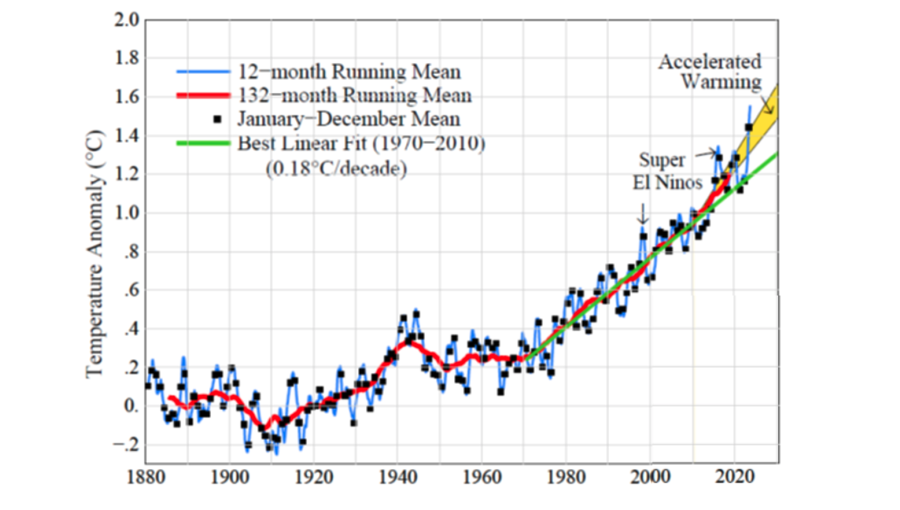Global warming acceleration at its peak but the La Nina effect this year will reduce temperatures less than expected

Global temperatures are now near their peak due to the El Niño aerosol decrease, but how far will they fall in the coming La Niña?
If the El Niño/La Niña average is ~1.5C, given Earth’s energy imbalance, we are now passing through 1.5C, for practical purposes.
Global temperatures (12-month mean) are still rising at 1.56°C relative to 1880-1920 in the GISS analysis through April, and are likely to continue to rise a little for at least a month before peaking this summer, before then declining as the El Nino fades toward La Niña, say scientists.
“Acceleration of global warming is now hard to deny. The GISS 12-month temperature is now 0.36°C above the 0.18°C/decade trend line, which is 3.6 times the standard deviation (0.1°C). Confidence in global warming acceleration thus exceeds 99%, but we need to see how far (the) temperature falls with the next La Niña before evaluating the post-2010 global warming rate,” Dr James E. Hansen, a climatologist at the Earth Institute at Columbia University said in a recent update.
The La Niña climate phenomena where temperatures fall following its sister El Niño effect was experienced in 2023. However, in this cycle the effect will be reduced by an increase in the Earth Energy Imbalance (EEI) – an increase in heating by the sun as more sunlight reaches the earth’s surface after reflective sulphur dioxide was removed from shipping fuel in recent years.
As a result of this change, as bne IntelliNews reported, the climate models are wrong and are underestimating the rate at which global warming is accelerating.
Present extreme planetary energy imbalance will limit La Niña-driven temperature decline. Thus, the El Nino/La Niña average global temperature is likely about 1.5°C, suggesting that, for all practical purposes, the global temperature has already reached that milestone,” says Hansen. “In other words, we are beginning to realise the consequences of the Faustian bargain, in which humanity partly offset greenhouse gas warming with aerosol (particulate air pollution) cooling.”
Hansen says that the rapid and unexpected acceleration of global warming since 2010 is due to the removal of the reflective aerosols, the effects of which have not been included in most climate models.
“We interpret acceleration of warming since 2010 to be a consequence of decreasing aerosols, with a significant contribution from reduction of ship aerosols due to the strict 2020 emission limit imposed by the IMO (International Maritime Organization),” says Hansen, which he says has been underestimated because ship emissions are a tiny part of total anthropogenic emissions and of emission changes.
“But ships emit into relatively pristine ocean air and the aerosol effect is nonlinear… An important issue concerns how much additional global warming lurks in our Faustian aerosol bargain. That depends on interpretation of ongoing change. Our preliminary analysis suggests a ship aerosol forcing an order of magnitude (factor of ~10) greater than what follows from United Nations’ Intergovernmental Panel on Climate Change (IPCC) estimates.,” says Hansen.
Hansen says the effect of the aerosol change is hard to measure and estimate as it works through its effect on clouds, and cloud cover is very hard to model.
“Cloud changes also occur as a climate feedback that is poorly quantified, and clouds have large natural variability,” says Hansen.


Follow us online